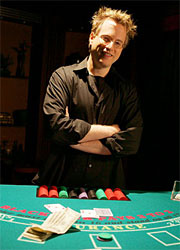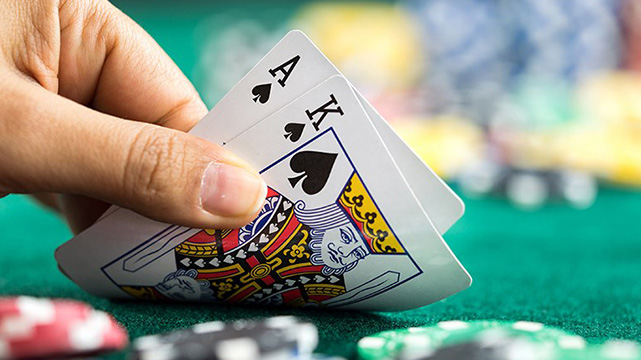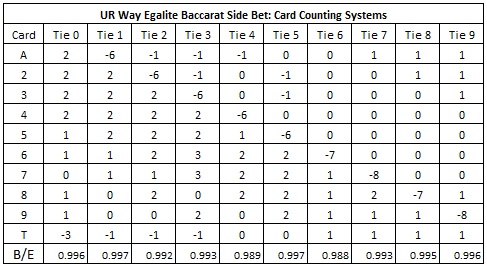- Mit Card Counting Method
- Mit Blackjack Card Counting System
- Mit Card Counting Team Members
- Mit Card Counting Movie
- Mit Card Counting Team
Contents
The trick to most card counting methods is categorizing the cards into two types. High cards; Low cards; The reason card counting works — or at least the biggest part of it — is the increased probability of being dealt a blackjack when the deck has lots of high cards left in it versus low cards. Next, the MIT team members learned a card counting system. This is a way to keep track of the cards as they are played after a shuffle. A grouping of cards, for example, the 2 through 6’s, are assigned a value or tag of plus 1. Likewise the high cards – tens, picture cards, and aces – have a minus 1 tag. Card counting is a system that experienced blackjack players use to get a profitable advantage over the casino. There are many individual “counts” or systems. Many of them are named after colorful professional gamblers from times past. The 2008 movie “21” bought card counting to. The 2008 incarnation of that now age old story sees Kevin Spacey train a bunch of bright MIT students in blackjack tricks and card counting. A lavish production with some excellent cameos from the likes of Lawrence Fishburne, this movie bounces neatly between high energy casino scenes and the emotional drama behind cunningly created facade.
Card Counting Is Easier Than People Think
It isn’t memorizing all the cards that come out of an 8 deck shoe. Instead, it is just knowing the difference between the number of small cards and the number of big cards.
People unfamiliar with card counting tend to think that it requires great memorization and this simply isn’t true. The misconception is that one must keep track of every single card to be successful.
The reality is that the player simply groups cards with a point system as follows:
2, 3, 4, 5, 6: +1
7, 8, 9: 0
T, J, Q, K, A: -1
Here is a graphical version of the groupings:
Getting rid of low cards is a good thing so we score positive points when that happens.
Mid cards are neutral so we don’t have to keep track of them.
Getting rid of broadway cards is bad, we need those big cards for blackjack! Our count loses points/value when these great cards get used up.

We only need to know the difference between the number of small cards that have been used up and the number of big cards. It’s as simple as that.
Hand Example
It’s the first hand of the shoe. I stand on T4 since the dealer is showing a 6. He then shows a 2 as his other card. He hits and gets a Jack (J).
What is the count at the end of this hand?
If you answered +1 then you’re right. Here are the details:
T: -1
4: +1
6: +1
2: +1
J: -1
—–
total: +1
This is the running count but what really matters is the true count. We’ll get to the true count later.
Another Hand Example
As we saw above, the first hand of the shoe gave us a running count of +1. We’re now on the second hand and it goes like this:
Me: AQ
Dealer: 5K7
Here are the count details for this second hand:
A: -1
Q: -1
5: +1
K: -1
7: 0
—-
total: -2
What is the running count now? It was +1 at the start of this second hand. The second hand deducted 2 points from the running count so now the running count is -1.
Running Count
The running count is the sum of the individual counts of all hands in the shoe.
Mit Card Counting Method
If the individual count of the first hand in the shoe is +1 then the running count is +1. If the second hand in this shoe has an individual count of -2 then the running count becomes -1. If the third hand in this shoe has an individual count of +3 then the running count becomes +2.
True Count
The true count is the running count divided by the number of decks left in the shoe. For example, if there are 2 decks left in the shoe and the running count is +4 then the true count is +2. On the negative side, if the running count is -6 and there are 2 decks left then the true count is -3.
Betting Strategy
If the true count is near 0 or below 0 then players bet the minimum. Players bet more as the true count gets high above 0. We use a betting system where the betting unit is the same as the table minimum. Starting with +1, every one point increase in the true count adds another betting unit.
Here is our betting strategy on a $10 minimum table:
Count 0 or Less: bet $10
Count +1: bet $20
Count +2: bet $30
…
Count +x: bet 10*(x+1)
Our blackjack betting strategy section has more details on the thinking behind our betting strategy.

Card Counting Systems: Hi Lo vs Hi Opt
Everything we’ve explained here is for the Hi Lo card counting system. The Hi Opt card counting system is almost the same thing except that in Hi Opt the deuces and aces are not counted. In other words, in Hi Opt both A and 2 are 0 instead of -1 and +1 respectively.
Online Practice
Of course the best way to practice card counting online is to use our trainer tool. Beginners have the option of trying a few hands to make sure they get the right count on each hand individually. Intermediate counters can go through the shoe and see if they are able to keep the correct running count. Advanced players can make sure they are sizing their bets correctly based on the true count.
Offline Practice
Find a deck of cards and deal out all but one while keeping track of the running count. At this point the count is either -1, 0, or +1. Based on this information, you know if the last cards is small, medium, or large. After the last card is dealt then the count is back to zero if you counted all the cards correctly.
Save The Big Bets For Times When Odds Are Good
This isn’t rocket science. Instead of randomly changing the size of bets, players should increase bet sizes when the true count says odds are good.
By Henry Tamburin
Bringing Down The House by Ben Mezrich, a book the describes how a team of MIT students won millions playing blackjack, has sparked a lot of interest from the general public in blackjack and in particular card counting. The book was a NY Times bestseller and it was made into amovie (“21”). Because of all this publicity about the MIT team and their accomplishments, I’ve been receiving a lot more inquiries about how this team of students was able to pull off their bigscore. Here is how they did it.
First off, they didn’t cheat. They basically learned the following skills- the basic playing strategy, card counting, and team play - to win at blackjack.
Basic strategy is simply a set of rules that tells you the best way to play every hand dealt to you. For example, one of the basic strategy plays is to always split aces and 8’s no matter whatthe dealer’s upcard. You can find the basic strategy in blackjack books (including my Blackjack: Take The Money & Run) and it is a pre-requisite for winning at blackjack.
Next, the MIT team members learned a card counting system. This is a way to keep track of the cards as they are played after a shuffle. A grouping of cards, for example, the 2 through 6’s, areassigned a value or tag of plus 1. Likewise the high cards – tens, picture cards, and aces – have a minus 1 tag. They add and subtract the tags for each card that is played from theshuffled deck(s) to arrive at a sum known as the running count. The more positive the running count, the more high cards are left in the undealt cards which gave them the advantage, so they betmore (often tens of thousands). When the running count was negative, they bet less because there was an abundance of small cards left in the undealt cards a situation which gave the house adecided advantage. The team members, therefore, waited for the deck to get good before they bet large sums of money.
Steve interviews Mike Aponte of the MIT Blackjack Team. They discuss:
- how Mike first became involved with the team
- how they operated
- his role on the team
- and their biggest success
- Mike also explains what he did after the team broke up
- what he is doing today
- and his best advice for blackjack players.

The member of the MIT team did not play solo much like most card counters would do. They went one step further by using spotters, Big Players, and a team bank. Here’s how this works.
Mit Blackjack Card Counting System
Several spotters would enter a casino and position themselves at different blackjack tables. They counted and when the count went positive, they wouldn’t increase their bets, but rather signalanother team member (known as the BP or Big Player) to enter the game with big bets. The BP continues to bet big until the spotter gives another signal that the deck has gone bad (or negative)and then the BP leaves the table. The BP basically wanders around the casino waiting for another call-in from a spotter.
Because the spotters always bet the minimum on every hand the casino is less likely to finger them as card counters. The BP acts and appears as just another high roller as he enters the gamemaking large bets hand after hand. Depending on how high the count was when he’s signaled into the game, the BP’s edge can be quite high.
The BP must know the spotter’s signals. For example here’s a few signals mentioned in the book: Arms folded across the chest means the deck is warm; Arms folded behind the back indicates thedeck is hot; Hands in the pockets indicate the deck is even hotter;
Running a hand through hair means something is wrong - get out of the casino - fast!
Besides the physical signals, their team also used oral signals to indicate to the BP what the count was so the BP knew how much to bet. These oral signals were keywords that they would use ina sentence. For example, tree meant a count of plus 1. Stool was plus 3, bowling was plus 10. So if the spotter said something like “I’d rather be bowling right now” that indicated to the BPthat the count was plus 10 and. Therefore. he knew how much to bet.
Probably the biggest weapon the MIT team had going was a team bankroll. Not only did each player put up a sum of money, but investors had invested in the team. With one large team bank, everyplayer on the team used this one combined, large bankroll as if it were his or her individual bankroll. This in turn allowed the MIT team players to bet larger amounts of money with the samerisk compared to playing solo. And the greater amount of money that a card counter can get on the table, the more money he or she stands to win. This is what makes blackjack teams sopowerful.

Here’s an example of how a team bank works compared to a card counter that plays alone. Suppose Player A plays solo with a $5,000 bankroll and wagers up to $100 per hand when the advantageshifts in his favor. His earning potential as a card counter is $25 per hour.
Player B joins Player A to form a team. Their combined bank is $10,000 allowing each player to increase their maximum bet from $100 to $200. The team of two players' profit potential isnow $100 per hour so each player averages $50 per hour profit, twice the earnings compared to playing solo.

As a general rule the profit potential of a team of skilled players is equal to the profit potential of each individual if playing solo times the number of players on the team squared. So if acard counter has the potential to earn $25 per hour playing blackjack, this is what he could earn playing on a team.
Solo Earnings Potential Number of Team Players Individual Earnings on Team
$25/hr 2 $50/hr.
$25/hr 3 $75/hr
$25/hr 4 $100/hr.
$25/hr 5 $125/hr.
Mit Card Counting Team Members
The more members on the team the more money a card counter stands to earn. And of course the more you money you wager the higher the individual earnings.
Playing on a team also smoothes out the bumps in the road and makes the negative swings more manageable and tolerable. Teams also play more hands per hour compared to a solo player so they willget into the “long-run” a lot quicker. This means that the probability is higher that a team of players will be ahead after playing x hours compared to a solo player playing the same x hours.
The life of a card counter can be lonely, especially when they are losing. But when they are playing on a team and have a disastrous losing day, members often provide support and sympathizewith their plight (this is clearly brought out in the book). There is also the possibility that even though one member of a team lost, other team members have won. Secondly, having agroup of individuals trying to achieve the same goal (winning x amount of money) often provides an uplifting psychological advantage. Thirdly, team players are more apt to share intelligenceabout games with better rules and penetration which makes winning easier for all team members.
Mit Card Counting Movie
It took months and months of practice before the MIT team members were ready to take on the casinos. And even though they won money in the long run, over a few days and weeks of play they tooktheir lumps, which is normal for card counting. Their key to success was their understanding of risk and return and their large bankroll.
Mit Card Counting Team
Henry Tamburin has been a respected casino gambling writer for the past 50 years. He is the author of the Ultimate Blackjack Strategy Guide and was editor of the BlackjackInsider newsletter. You can read his latest articles on blackjack, video poker, and his personal playing experiences at https://www.888casino.com/blog/writers/henry-tamburin